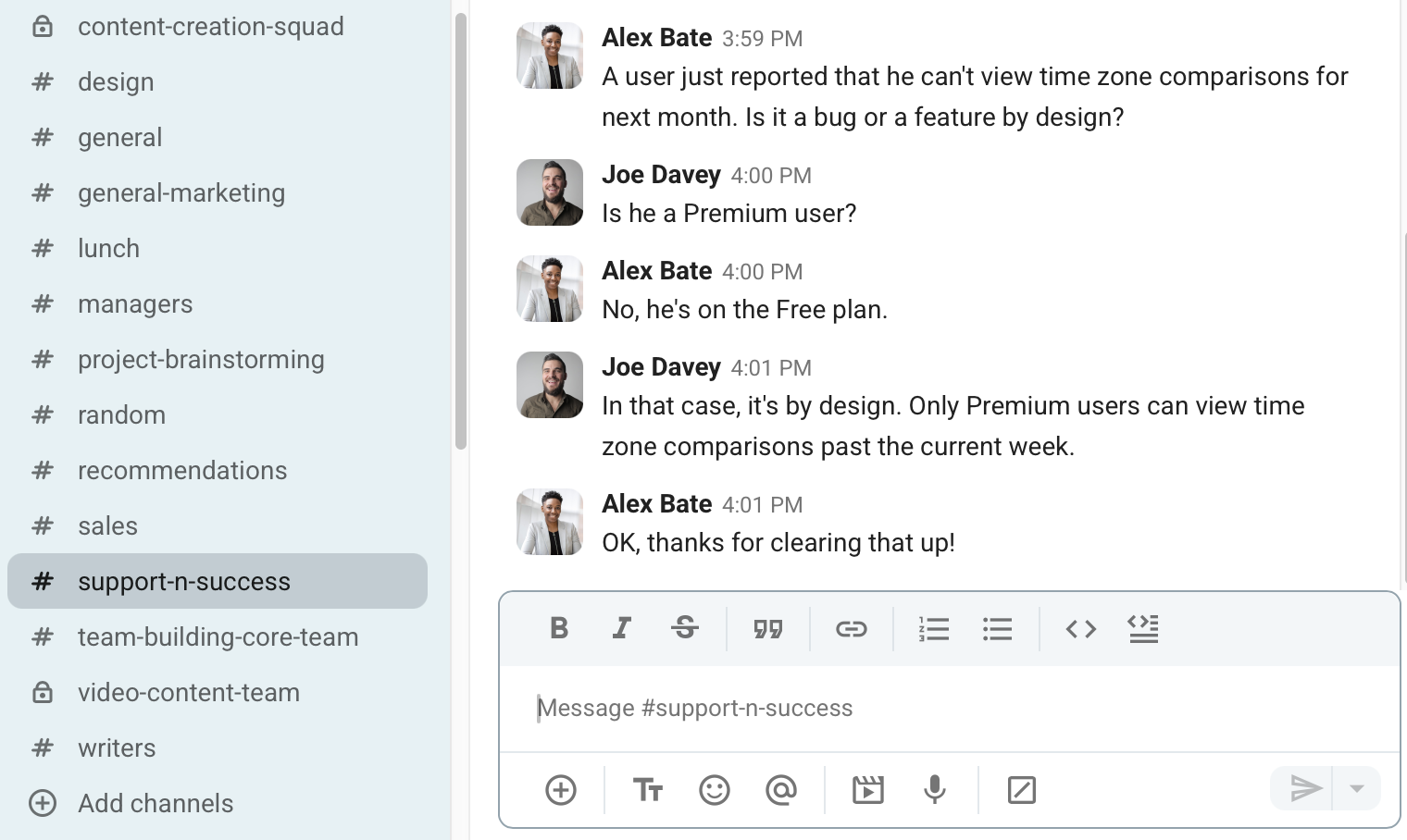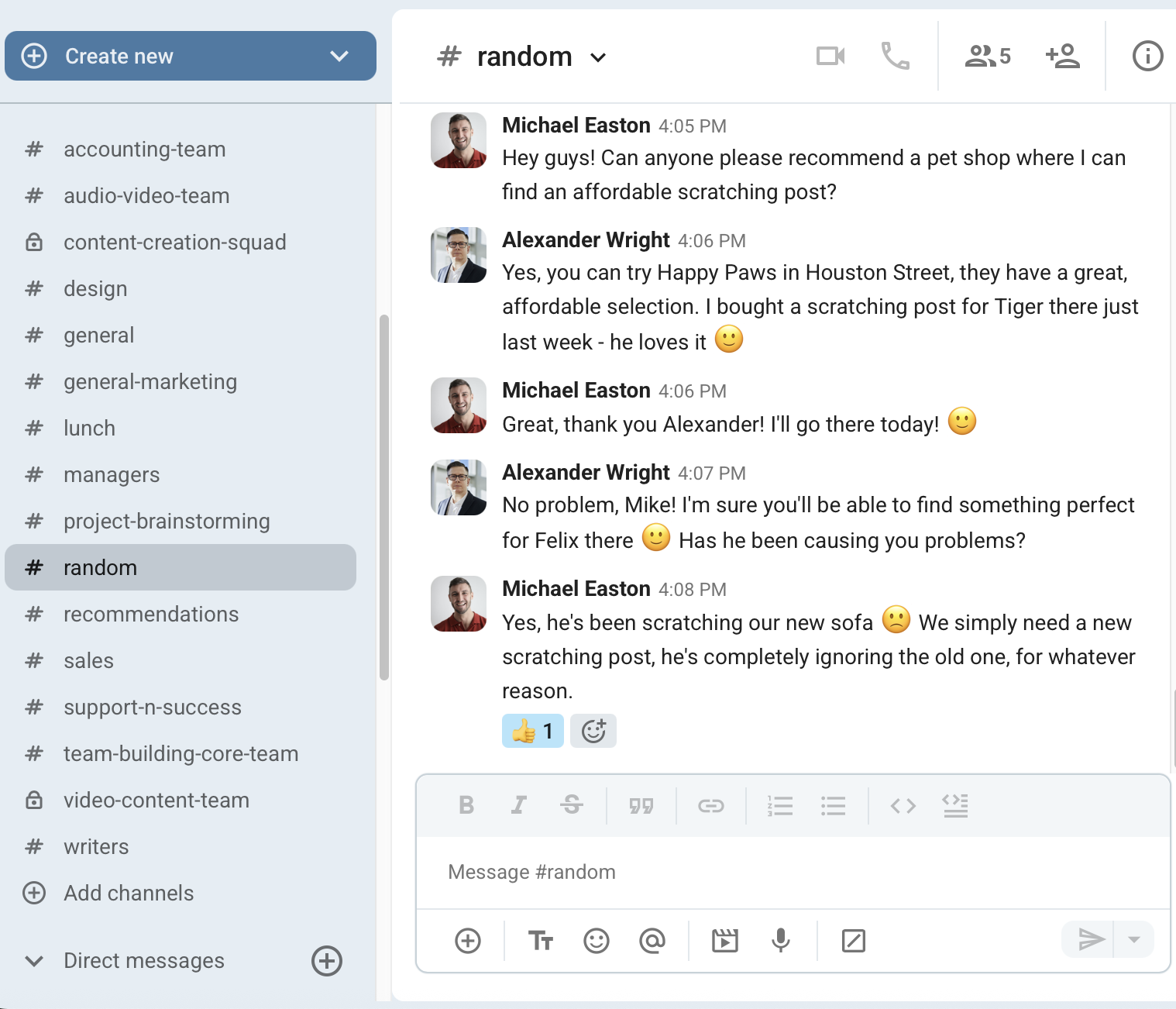Group communication takes place when 3 or more people engage in a conversation verbally or in writing. In a business setting, it refers to communication between a group of a minimum of 3 professionals with a common goal of sharing ideas and information, collaborating on a project, resolving issues, or negotiating a deal.
Effective group communication is essential to achieving virtually any business goal.
To help organizations better understand group dynamics and improve their group communication, in this blog post, we are going to:
- Define group communication,
- List out the advantages and disadvantages of group communication, and
- Offer tips on how to improve group communication.
So, let’s dive in.

Table of Contents
What is group communication?
Group communication refers to any verbal or nonverbal interaction between a group of 3 to about 20 people.
Size plays an important role in categorizing a communication situation as group communication because it determines the ability of each member to interact with every other participant in the conversation and be mutually influenced.
A group of 20 or fewer participants is commonly referred to as a small group, whereas communication between 2 individuals is characterized as interpersonal communication.
What are the main features of group communication?
To get a better understanding of group communication, let’s look at all the features that affect its outcome and define it more closely.
Group communication consists of the 6 main features:
- Participants — senders and receivers of the messages.
- Message — the piece of information communicated across a group.
- Noise — any external element that affects the original message and how it is interpreted and perceived. Anything from environmental noise and ambiguous body language to cultural barriers and lesser-known jargon can fall into this category.
- Context — external circumstances and conditions in which the communication takes place that largely determine how the message is interpreted. Some of the factors that make up the context in group communication are:
- The situation,
- Culture,
- Environment,
- Time,
- Place, and
- Roles of the participants.
- Channel(s) — the medium used to conduct the communication (e.g. business messaging app, email, phone, etc.).
- Feedback — the response made by the receiver(s) of the message.
Internal structures in group communication
Now that we’ve defined structure in group communication in a general sense, let’s move on to how it’s affected by internal group structure.
Rather than previously mentioned external factors, the internal structure is defined within the team’s or organizational hierarchy, and it largely determines the nature and the outcome of group communication.
Essentially, there are two main internal structure types in group communication:
- Centralized — Refers to groups that have a central figure (authority) that guides the conversation.
- Decentralized — This structure allows equal stakes to all participants in group communication, without a leader facilitating the conversation in a group.
Most commonly, a centralized structure works better for communicating urgent tasks, whereas a decentralized structure is more appropriate for communicating more complex tasks that don’t require immediate action, according to the research found in the book “Small Group Decision Making” by Donald G. Ellis and B. Aubrey Fisher.
Group communication channels
There are many different forms or channels group communication can take place in.
The most common group communication channels include:
- Formal in-person team meetings — A group of coworkers or a team gather in an office or other formal setting to discuss project progress, future objectives, or current issues. Usually, these types of interactions are guided by a leader figure, such as a manager.
- Informal in-person group gatherings — Although commonly connected to social groups outside the workplace, informal gatherings also take place with groups from the same organization. Some examples include company parties, wellness retreats, or team-building events.
- Group emails — A form of written group communication most commonly used for formal exchange between groups working on shared projects. Group emails aren’t the most effective solution, especially in urgent situations that require a fast exchange and quick access to critical information.
- Conference calls — Conference calls allow the immediacy of in-person meetings, with the added benefit of allowing participants to join from anywhere. Usually conducted via video conference tools, conference meetings are commonly guided by a central, leader figure.
- Group message chats — Team members or groups working on a shared project use team communication apps to share progress updates, chit chat, discuss ideas, and share files and documents with team members or external stakeholders.
- Memos — Memos or memorandums follow a more formal communication form between groups. Memos are used to communicate important updates, tasks, and policy changes usually across the organization, but can also be used to communicate group-specific information.
- Project management task lists — A group working on a shared project uses project management tools to display, track, and communicate deadlines, status updates, as well as further discussions.
💡 PUMBLE PRO TIP
To learn more about the different types of communication channels and when to use which one, read our article on the topic:

Why is group communication important?
The importance of group communication, especially in a business environment, is multifold. In addition to facilitating teamwork and collaboration, group communication is also integral to the social aspect of team interaction.
Moreover, messages exchanged within group communication facilitate decision making by ensuring that all team members clearly understand the issue, share relevant information, and contribute ideas. This leads to more informed and timely decisions.
Also, clear and respectful group communication helps with conflict management by addressing issues early and finding a common ground.
Group communication essentially determines the entire dynamic of the group as well as the overall project success.
Advantages and disadvantages of group communication
In theory, group communication generates plenty of benefits to organizations in terms of facilitating collaboration and creating opportunities for team bonding.
However, we’ve all witnessed at least one instance of group communication gone wrong, whether due to external factors like physical barriers or due to interpersonal team dynamics.
Although benefits outweigh the disadvantages, it’s still important to consider both when looking for opportunities for improvement of group communication.
Advantages of group communication
Group communication is a key factor facilitating virtually any process within an organization.
Let’s go over a list of its advantages:
- Better transparency and clarity among group members about goals and expectations — Group members that frequently communicate are more likely to establish trust and transparency among themselves. Effective group communication — when practiced regularly — offers plenty of opportunities to share regular updates across teams and foster transparent communication.
- Improved teamwork and collaboration — Effective team communication is one of the key facilitators of successful collaboration.
- Increased productivity — Effective group communication between team members drives productivity and ensures better results.
- More effective decision making — Multiple perspectives present in effective group communication contribute to better objectivity and accuracy when making decisions within teams.
- Closer relationships and improved trust between team members — Open, frequent, and respectful communication is a key driver of relationship building between team members.
Disadvantages of group communication
While group communication provides plenty of benefits, there are specific challenges and barriers to be mindful of when working towards improving group communication.
- Physical barriers — When group members don’t occupy the same physical space, it can pose a potential challenge to group communication. Moreover, inadequate communication tools and poor internet or phone connections can also hinder communication quality.
- Perceptual barriers — Personality types and the general outlook on life of the group members play an important role in how each individual group member will perceive the work tasks and messages in group communication.
- Emotional barriers — The current emotional state of the participants in the group communication affects how they will formulate and interpret messages. An individual going through a rough time can change the group communication dynamic.
- Interpersonal barriers — Group communication is also largely affected by how individual group members perceive themselves. Overly confident individuals will interact in a completely different manner than group members who are more insecure.
- Cultural barriers — Misunderstanding body language, making assumptions, and relying on stereotypes are still some of the biggest challenges in intercultural communication, as shown in a recent study. As the number of international teams increases, organizations need to put more emphasis on overcoming these barriers to perfect cross-cultural communication across their teams.
- Language barriers — Although formally considered as a cultural barrier, language barriers in group communication can occur even when all members speak the same language. Specific technical terminology or industry jargon can also cause misunderstandings.
💡 PUMBLE PRO TIP
For a more in-depth analysis of communication barriers, be sure to check out our ultimate guide:
Tips for improving group communication
Successful team collaboration relies on each member having strong group communication skills. Otherwise, your team communication may give way to misunderstandings and conflicts, which can decrease overall productivity and cause unnecessary delays.
To avoid this scenario, adopt these 7 tips to promote effective group communication and help your teams collaborate better.
Tip #1: Assess communication styles of group members
One of the greatest challenges of group communication is that there is no universal style of communication each individual participant will use.
Diversity, in this regard, is both a gift and a curse. However, taking the time to assess and understand where your team members come from when it comes to communication styles will go a long way in improving your group communication.
It will help you better understand how different individuals like to communicate and identify shared traits you can center your group communication improvement around.
💡 PUMBLE PRO TIP
To learn how to identify and understand different communication styles, read our full guide:
Tip #2: Offer support and effective communication training
Once you’ve done the groundwork of assessing your group’s communication styles, you’ll understand that not all members are as skilled communicators as you might think. Thankfully, there are ways to improve group communication in your team by making the most out of each member’s potential.
Courses, workshops, and communication training tailored to target specific group communication challenges are all great ways to refine individual communication skills and improve communication in a group.
Depending on the specific group communication challenges you identify in your group dynamic, you can also design workshops that target specific communication elements, such as collaboration, negotiation, or public speaking.
Moreover, group communication training can address specific channels of communication such as writing effective announcements in your company team chat, for example.
Tip #3: Embrace transparent communication
Transparency and openness in workplace groups are vital. They not only facilitate more efficient group communication and collaboration, but also foster mutual trust and support innovation.
Conversely, a lack of transparency brings about severe challenges that damage productivity and teamwork. Without clear transparency guidelines and incentives in place, teams may resort to the pesky silo mentality, gossip, and micromanagement, all of which stand in the way of productivity and positive workplace culture.
On the other hand, when team members feel heard and valued in a transparent workplace environment, they are more likely to increase their engagement and productivity. Group communication thus improves, as each individual feels empowered to participate and express their point of view.
To promote transparency in group communication, consider the following steps:
- Encourage vulnerability to develop trust. Create a culture of authenticity where people feel comfortable sharing transparently.
- Share real-time updates. To keep everyone in the loop, consider creating a practice of providing timely updates on all major tasks and projects.
- Give reasons for withholding specific information. Don’t leave room for assumptions, explain specific confidentiality restrictions.
- Encourage empathy with respect for privacy. Show empathy for people’s issues without invading their privacy.
- Use simple vocabulary. Promote simplicity in group communication and discourage the use of industry jargon to avoid alienating people from different departments or with different experience levels.
- Create direct communication channels with tools. Use business messaging tools that allow instant communication and feedback.

💡 PUMBLE PRO TIP
To get more in-depth insight into the principle of open communication at the workplace, be sure to visit our guide on the blog:
Tip #4: Define individual roles
Clear roles in teams allow for smooth collaboration and successful communication between group members. When each member of the group has a clear understanding of their roles and responsibilities, group communication becomes more structured and constructive.
Not establishing individual roles can lead to a number of potential group communication challenges. For example, when team members don’t have a clear understanding of what is expected of them in terms of behavior, they might unintentionally break the code of conduct and overshare, or engage in inappropriate behavior such as gossip.
To avoid misunderstandings, conflict, and miscommunication in your teams, consider assigning each team member a clear set of responsibilities and expectations. That way, you can eliminate any potential ambiguity and improve overall group communication.
Tip #5: Foster collaboration
In a group setting, no task or project is done in a vacuum, or individually. Any project or task’s success is a result of a group effort. This form of collaborative culture, once established, reflects in group communication.
Group members that have developed a team-centric mindset understand the importance of effective and respectful communication in team collaboration, conflict resolution, and negotiation.
To establish a sense of teamwork and ensure each individual member communicates with the group’s/project’s best interest at heart, consider allowing more opportunities for team bonding through informal conversations. If your team operates on-site, provide a place for weekly team gatherings where people can chat and bond over shared interests.
For remote teams, consider creating dedicated channels in your business messaging app where your team members can have regular communication and get to know each other better.
That way, you’re letting your team build meaningful relationships that translate into how they communicate during teamwork.

💡 PUMBLE PRO TIP
For an extensive list of steps towards better collaboration, visit our ultimate guide:
Tip #6: Lead by example
Group communication, at the end of the day, is only as effective as leadership communication.
Essentially, your team will consciously or subconsciously look up to you and mirror your communication style. It’s up to you to make this more of a conscious choice and role-model the behavior and communication you want to see practiced in group communication in your team.
When looking to role-model effective communication to a group, consider applying some of the most important leadership communication skills that translate into better group communication. In addition to being assertive in your communication with the team and willing to own up to your mistakes, consider building on:
- Confidence,
- Transparency,
- Active listening,
- Kindness, and
- Empathy and perspective.
💡 PUMBLE PRO TIP
To further explore leadership communication and learn how it affects teams, be sure to check out our guide on the blog:
Tip #7: Utilize the right communication channels
Group communication takes place in several different forms via different communication channels. It’s paramount for employees to have a clear understanding of which communication channels to use for different types of group exchange.
Without a clearly defined set of reliable tools, workplace groups are more likely to face miscommunication and misunderstandings, which hurt team efficiency. In fact, 24% of respondents identified unfit internal communication tools as the main barrier to effective workplace communication.
Depending on the work model, the line of business your organization operates in, or team preferences, you will default to using specific group communication channels exclusively or more frequently than others.
However, there is another important element to consider when establishing official communication channels, and it has to do with generational inclusivity.
We reached out to Mark Beal, Assistant Professor of Professional Practice, Communication at Rutgers University School of Communication and Information, and asked to hear his perspective.
Professor Beal highlights the importance of communication channels in improving group communication. He suggests that generational inclusivity and communication channels go hand in hand.

“There are two key elements to successful group communications in business today – inclusivity and the channels of communication. Today’s workplace includes executives across 4 generations – Gen Z, Millennials, Gen X, and Boomers. For communication to be effective, everyone — from juniors to senior executives — need to be included and genuinely feel like they belong in the conversation and can actively participate.”
He also pointed out how evolving communication channels require group members to feel confident using them:

“As new communication channels such as Pumble, Teams, and even texts are emerging to complement traditional email communication, all members of the group have to feel comfortable with utilizing those new channels, or they will not feel like they belong and thus won’t participate. Inclusivity, belonging, and a comfort level with emerging channels will result in more effective group communication as business continues to evolve and transform.”
Improve group communication with Pumble
Group communication plays a big role in how your team works together. When it’s unclear or inconsistent, it often leads to misunderstandings, slower progress, and frustration.
With the right habits — and the right tools — your team can stay connected, productive, and on the same page.
With a robust team communication app like Pumble, your team has everything they need in one place. From organized channels and threads for focused conversations, to quick direct messages when something needs to be handled fast — Pumble has it all.
You can share files, jump on a voice or video call, or even bring in external partners with guest access — all without switching platforms.

Pair the tips in this article with Pumble’s features and you’ll create a communication flow that supports teamwork and brings in excellent results.
Make group communication easier than ever — try Pumble today!




